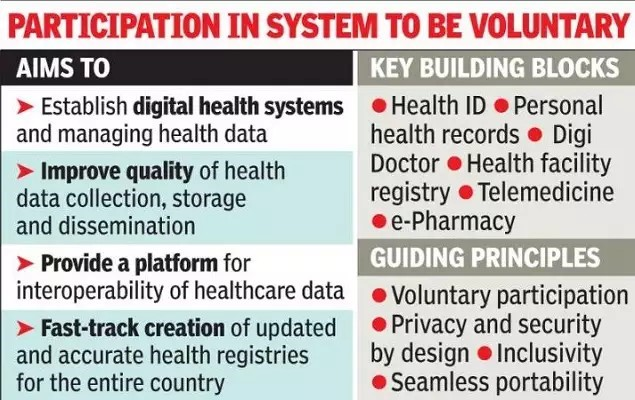AYUSHMAN BHARAT DIGITAL MISSION

Copyright infringement not intended
Context - The National Health Authority (NHA) has organized a convention for technology partners of the Ayushman Bharat Digital Mission (ABDM).
Details
- The National Health Authority (NHA) has organised a convention for technology partners of the Ayushman Bharat Digital Mission (ABDM) in New Delhi on 13th May 2022.
- The National Health Authority is responsible for implementing the Health insurance/assurance scheme Ayushman Bharat Pradhan Mantri Jan Arogya Yojana (AB-PMJAY).
- The Convention has brought together representatives from over 40 health tech organizations from the public and private sectors to discuss the different ways in which the digital health ecosystem of India can be strengthened further.
- The main objective of the Mission is to leverage technology to deliver health care services to remotest areas of the country.
About Ayushman Bharat National Digital Mission
- It will ensure access to quality healthcare by promoting the use of technologies such as telemedicine and supporting the national portability of health services.
- Citizens can create their ABHA (Ayushman Bharat Health Account) numbers, to link their digital health records.
- The National Health Authority will be the implementing agency of the Ayushman Bharat Digital Mission (ABDM).
- It aims to create a National Digital Health ecosystem that supports universal health coverage in an efficient, accessible, inclusive, affordable, timely and safe manner.

Copyright infringement not intended
Concerns
- Privacy concerns and misuse of data.
- Exclusion of citizens and denied healthcare due to System failure or technical errors.
Present status of Healthcare in India
- According to WHO Study, 34% of Indians are physically inactive.
- The fertility rate in 23 States and UTs including all the Southern States is below the Replacement rate while it is higher in several States in Central, east and northeast India.
- Despite increasing knowledge of Contraceptive methods men have not taken up the responsibility of managing fertility.
- India 3rd the most obese nation after the US and China.
- Non Communicable diseases are top killers' Diabetes, Cancer and heart disease Cause over 70% of deaths.
Steps by the Government
- Promotion of Institutional deliveries through Cash incentive under Janani Suraksha Yojana.
- Janani Shishu Suraksha Karyakram: Free ante-natal Check-ups, Postnatal Care and treatment of Sick infants till one year of age.
- Providing Reproductive, Maternal, Newborn, Child and Adolescent Health Services, the establishment of Special Newborn Care Units.
- Home Based Newborn Care is being provided by ASHAs.
- MAA for improving breastfeeding practices.
- Pradhan Mantri Dialysis Program.
- Mission Indradhnaush: Expanding full immunisation Coverage, the introduction of new vaccines.
- PM Swasthya Suraksha Yojana for strengthening the tertiary health Sector.
- POSHAN Abhiyaan to address Malnutrition.
- Iron and folic acid Supplementation for Prevention of Anaemia, home visits by ASHAs to promote breastfeeding and promote the use of ORS and Zinc for management of diarrhoea in children.
- Medical Devices Rules, 2017: Transparent regulatory System, Ensure Safety and quality of medical devices, Allowed 100% FDI in medical devices Sector to Promote Make in India.
- National Health Resource Repository: Create a reliable, unified registry of the Country’s healthcare resources showing the distribution pattern of health facilities and Services between Cities and rural areas - ISRO is a technology Partner for providing data Security.
- Allowed 100% FDI in the Medical devices Sector to promote Make in India.
- Kayakalp initiative to Promote Cleanliness, hygiene and infection control practices in public health facilities.
National Health Policy 2017 targets
- Shifts From communicable to non-communicable diseases.
- Collaborating & regulating the private sector.
- A shift from Sick-care to wellness.
- Increase Life Expectancy at birth from 67.5 to 70 by 2025.
- Reduction of TFR to 2.1 at national and Sub-national levels by 2025.
- Reduce Five Mortality to 23 by 2025 and MMR from current levels to 100 by 2020.
- Reduce infant mortality rate to 28 by 2019.
- Reduce neonatal mortality to 16 and the stillbirth rate to “single-digit” by 2025.
- Reduce premature mortality from cardiovascular diseases, cancer, diabetes or chronic respiratory diseases by 25% by 2025.
Steps need to be taken
- Reduce the Pressure on Secondary and tertiary hospitals by investing in Preventive and Primary Health Care facilities.
- Early detection and Prevention.
- Provide adequate protection to doctors.
- Increasing the Doctor-Patient ratio.
- Reduce Out Of Pocket Expenditure.
- Increase the number of vaccines under Mission Indradhanush.
- Increasing the number of drugs and medical devices under price control.
- The Ministry Should Standardise the Cost of Certain treatments.
- Raising Public Health expenditure to 2.5% of GDP.
- Provide accessible, affordable and quality health care.
- Inform and educate people about the traditional Systems of medicine.
- Ayurveda Doctors and Yoga Teachers for Rural Areas.
- Improve Hospital access, Health worker density, and Access to essential medicine.
- Mobile Medical Units to Provide outreach Services in rural and remote areas.
Way Forward
- Based on the foundations laid down in the form of Jan Dhan, Aadhar and Mobile (JAM) trinity and other digital initiatives of the government, Ayushman Bharat Digital Mission is creating a seamless online platform through the provision of a wide range of data, information and infrastructure services, duly leveraging open, interoperable, standards-based digital systems while ensuring the security, confidentiality and privacy of health-related personal information.



1.png)
